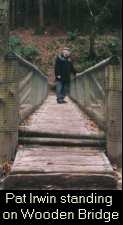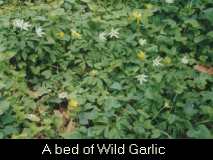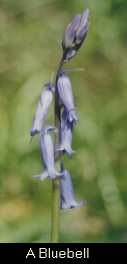










| ||
| Stop 7 Here we find more oak trees. Notice the moss and lichens growing on the trunk of the trees; this indicates an unpolluted environment. You will also notice the fern, Polypody, growing on the branches of this and other trees in the wood. The footpath here is a former mill race. Up to 1948 the water running through this channel caused the erosion noticable on the banks. |
 | |
| ||
Stop 9
At this stop we are at a river crossing with a beautiful wooden footbridge.
This used to be the spot where you could first distinguish the rumbling
sounds from the man-made waterfall which was situated further upstream. Unfortunately the Lake had to be drained on expert advice for reasons of safety and the river was re-routed which is why there is no longer a waterfall.
a beautiful wooden footbridge.
This used to be the spot where you could first distinguish the rumbling
sounds from the man-made waterfall which was situated further upstream. Unfortunately the Lake had to be drained on expert advice for reasons of safety and the river was re-routed which is why there is no longer a waterfall.
| ||
| HOME| PREVIOUS| START THE TRAIL| STOPS 1-3| STOPS 4-6| STOPS 10-12| STOPS 13-15| STOPS 16-18| GALLERY 1| GALLERY 2| GALLERY 3| GALLERY 4| BRIEF HISTORY| | ||
Website designed and maintained by Orla Irwin.
 Stop 8
At this stop we can see examples of the plants which
are usually found growing
under hardwoods,especially the oak.There is an
abundance of Wild Garlic distinguishable by it's
strong smell.
Stop 8
At this stop we can see examples of the plants which
are usually found growing
under hardwoods,especially the oak.There is an
abundance of Wild Garlic distinguishable by it's
strong smell.
 Also present are Herb Bennett, Herb Robert, Nettle,
Lesser Celendine, Lords and Ladies and several species
of ferns.These plants form the ground layer of the
woodland flora. Honeysuckle, also called Woodbine,
is a climbing plant and produces lovely flowers
which give off a most beautiful scent at dusk.
Many plants which flower in spring such
as Bluebell and violets make use of the
sunshine before the hardwood canopy casts it's summer shade.
Also present are Herb Bennett, Herb Robert, Nettle,
Lesser Celendine, Lords and Ladies and several species
of ferns.These plants form the ground layer of the
woodland flora. Honeysuckle, also called Woodbine,
is a climbing plant and produces lovely flowers
which give off a most beautiful scent at dusk.
Many plants which flower in spring such
as Bluebell and violets make use of the
sunshine before the hardwood canopy casts it's summer shade.